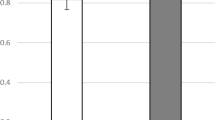The aim of the present work was to develop a method for color and rhythm therapy (CRT) for correction of psychoautonomic impairments in children with type 1 diabetes mellitus. This method was used in 62 children aged 7–16 years with signs of this illness who were investigated neurologically with additional psychometric assessment of endogenous and situational anxiety (Spielberger–Khanin test), stress resistance, communicative ability (St. Petersburg V. M. Bekhterev Psychoneurological Institute Scale), and autonomic disorders (Vein questionnaire). Color and rhythm therapy was performed using a Russian Tsvetoritm [Translator’s note: literally, Color-Rhythm] apparatus to use light of defined wavelengths for stimulation. This treatment was found to be quite effective in correcting psychoautonomic impairments, depending on the nature of emotional disorders, the characteristics of the influences of individual light stimuli (red, yellow, and blue colors), and the sequence and rhythm of their presentation; selection of an automatic operating regime was found to be optimal.
Similar content being viewed by others
References
L. P. Volkova, Mechanisms of the Autonomic Regulation of the Visual System and Approaches to Its Restorative Correction up Eye Diseases: Author’s Abstract of Doctoral Thesis in Medical Sciences, Moscow (2009).
R. V. Geim, L. M. Babina, and A. T. Tereshin, “Photosensory stimulation in the treatment of patients with neuroses and asthenodepressive syndrome,” Vopr. Kurort., No. 1, 11–13 (2004).
E. A. Zhirmunskaya and V. S. Losev, A System for the Description and Classification of Human Electroencephalograms [in Russian], Nauka, Moscow (1984).
V. K. Zrodnikov and E. A. Keshishyan, “Therapeutic actions of blue light: past and present,” Proc. 5th Russ. Conf. Contemporary Technology Pediatrics and Child Surgery [in Russian] Moscow (2006).
M. V. Korkina, “Borderline mental disorders in diabetes mellitus,” Zh. Nevrol. Psikhiat., 97, No. 2, 15–18 (1997).
M. I. Martynov, “Methods for the correction of complications in children with type 1 diabetes mellitus,” Med. Nauch. Ucheb.-Metod. Zh., Sect. Ucheb.-Metod. Posobiya, No. 9/10, 29–39 (2002).
I. L. Nikitina, “Characteristics of some functional parameters of the CNS in type 1 diabetes mellitus in children,” in: Proc. 10th Russ. Congr. Pediatr. Questions in Contemporary Pediatrics [in Russian] (2006), Vol. 5, Part 1, p. 419.
S. T. Turuspekova, Autonomic Disorders in Diabetes Mellitus with Cerebral Signs: Author’s Abstract of Master’s Thesis in Medical Sciences, Almaty (1995).
Yu. M. Urmanova, “Neuroendocrine impairments and the status of the central nervous system in children and adolescents with diabetes mellitus,” Sakh. Diabet., No. 1, 11–16 (2001).
Yu. L. Khanin, A Brief Handbook for the Use of the Spielberger Reactive and Endogenous Depression Test [in Russian], Meditsina, Leningrad (1983).
G. Bax, S. Lelli, and U. Grandis, “Early involvement of central nervous system in type 1 diabetic patients,” Diabetes Care, 18, No. 4, 559–562 (1995).
M. F. Folstein, S. F. Folstein, and P. R. McHugh, “Mini-mental state. A practical method for grading the cognitive state of patients for the clinician,” J. Psychiat. Res., 12, 189–198 (1975).
N. Uzun, D. Uluduz, S. Mikla, and A. Aydin, “Evaluation of asymptomatic central neuropathy in type 1 diabetes mellitus,” EEG Clin. Neurophysiol., 46, No. 3, 131–137 (2006).
G. Winkler and P. Kelmplar, “The pathogenesis of diabetic and hepatic neuropathies,” Orv. Hetil., 42, 2459–2467 (2001).
H. Yasuda, “New trends in pathogenesis of diabetic neuropathy,” Rinsho Shinkeigaku, 39, No. 1, 87–89 (1999).
Author information
Authors and Affiliations
Corresponding author
Additional information
Translated from Zhurnal Nevrologii i Psikhiatrii imeni S. S. Korsakova, Vol. 112, No. 8, Iss. I, pp. 39–43, August, 2012.
Rights and permissions
About this article
Cite this article
Filina, N.Y., Bolotova, N.V., Raigorodskii, Y.M. et al. Mental and Autonomic Impairments in Children and Adolescents with Type 1 Diabetes Mellitus and Their Correction with Color and Rhythm Therapy. Neurosci Behav Physi 43, 1107–1112 (2013). https://doi.org/10.1007/s11055-013-9857-2
Published:
Issue Date:
DOI: https://doi.org/10.1007/s11055-013-9857-2




